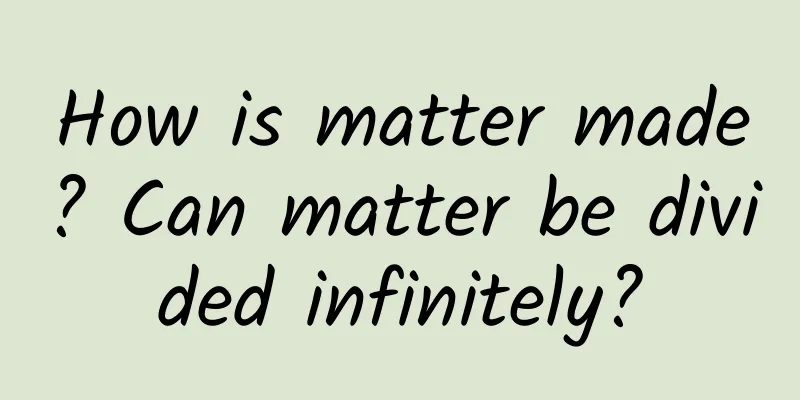How is matter made? Can matter be divided infinitely?

|
If you cut a piece of matter in half, it becomes two pieces of matter. If you take one of the pieces and cut it in half again, it can be divided into two pieces again. If you keep doing this, can you continue to divide it infinitely? This is an interesting question. Many people have thought about similar questions since elementary school. It is also an old question. Records of similar questions can be traced back to the ancient Greek period more than 2,800 years ago. Of course, science had not yet been born at that time, so people could only think about this question from a philosophical level. People wanted to explore the origin of all things by answering this question. Ancient Greek scholars we are familiar with, such as Pythagoras and Thales, have expressed their views on this issue. Among them, Democritus's view is closest to modern science. He believes that matter cannot be divided infinitely and there is a "smallest matter" in the world. Although Democritus proposed the concept of "smallest substance", what he said was only at the philosophical level. In the years before the birth of modern science, he had no way to answer what the "smallest substance" was. Now we have the answer. The world is made up of a variety of substances. The tables, chairs, benches, electrical appliances around us, the rocks, trees, bridges and streams outside the window, and even the various celestial bodies in the vast universe are all substances. These macroscopic substances can be divided, and can be divided many times until they are divided into single molecules. Most substances are made up of molecules, and there are also many substances that are directly made up of atoms. Take water as an example, it is made up of water molecules. Water molecules are extremely small. Generally speaking, a drop of about 0.05 ml of water contains about 100 trillion water molecules. Water molecules are very small, but they are not the most basic form of matter. We can further split water molecules, and we will find that water molecules are composed of two hydrogen atoms and one oxygen atom. Oxygen is a gas that we are more familiar with, because we have to breathe every moment, and breathing is inseparable from oxygen, and oxygen molecules are composed of two oxygen atoms. So is the oxygen atom the smallest unit of matter? Still not. We can further split the oxygen atom, and we will find that the oxygen atom contains two basic components, namely the nucleus and 8 extranuclear electrons. Can it be further split? Yes. If we open the nucleus, we will find that it contains protons and neutrons. Taking the oxygen nucleus as an example, it contains 8 protons and 8 neutrons. Is this the end? Indeed, scientists did think that protons and neutrons were indivisible at first, but then they thought, what would happen if they bombarded protons and neutrons with high-speed particles? When scientists really did this, they found that the bombarded protons and neutrons would deflect at three different angles, which means that there are other things inside the protons and neutrons, so protons and neutrons can still be split. So what is the matter smaller than protons and neutrons? It is quarks. This time it can finally not be divided anymore, which means that quarks are the smallest unit of matter, so they are also called "elementary particles." Of course, there is more than one kind of fundamental particle in the world. The electron outside the nucleus is also an indivisible fundamental particle, and there are many more than these. So a theory that can describe all the fundamental particles that make up matter has emerged, and it is called the "standard model." According to the standard model, there are as many as 61 known elementary particles, and these elementary particles can be divided into two types, namely fermions and bosons. It can be said that all matter in the world is composed of these elementary particles, so what role do fermions and bosons play in the composition of matter? Fermions are the smallest units that make up matter, which include the electrons and quarks we just mentioned. Interestingly, matter has mass, whether it is matter in the macroscopic world or molecules and atoms, but elementary particles are massless. How do massless elementary particles form matter with mass? This is where bosons come in. Bosons include photons, gluons, W bosons, Z bosons and Higgs bosons. Bosons are also elementary particles, so they naturally have no mass. However, bosons act as "adhesive" in the composition of matter. Their main function is to "transmit interactions", and the interactions between particles give matter mass. For example, when several quarks form a proton under the bonding effect of gluons, it has mass. All the matter known in the world today is composed in this way. It can be seen that matter cannot be divided infinitely, and the smallest unit of matter, that is, elementary particles, is indivisible. For more information, please follow the official account: sunmonarch |
<<: I have heard of "husband and wife look alike", but what the hell is "human-dog look alike"? !
Recommend
QQ can directly open Taobao links, but there is still a gap compared with JD.com and Pinduoduo
The reporter learned from multiple channels that ...
Animals imitate humans in fighting! Has your dog ever imitated you?
Review expert: Li Weiyang, a well-known popular s...
TikTok Promotion: The essence of TikTok is revealed in 3,000 words!
In the past two months, readers have been leaving...
Why are hydraulic rods so powerful? Can human power fight against hydraulic arms? A syringe will do
Hydraulic rods are widely used in our lives, from...
Urgent reminder! "Double typhoons" are approaching, and the intensity may exceed expectations! How to respond and prevent scientifically?
Central Meteorological Observatory issues typhoon...
The Light of Creation: What insights does the past, present and future of light bring us?
Light is so common and yet so special. It is ever...
Summary of daily development skills of Gradle
Gradle is the default build system in Android Stu...
6 information flow industry cases and delivery data, form costs exposed!
Today, Qingguajun will share with you the analysi...
E-commerce live streaming practical process summary
The market is very good, but you need to be cauti...
Are peanut milk and fruit-flavored milk substitutes for cow's milk? Just a few words difference, but big nutritional difference
Milk is rich in nutrients Not only rich in protei...
More than 100,000 followers in 4 days, let’s talk about user fission growth!
One year and several months of practical experien...
Taking Knowledge Planet as an example, we will teach you how to operate and promote a paid community
Community operation is a part of user operation i...
The Mystery of Gigantopithecus and Humans in Lingnan's Prehistoric History
Lingnan entered the Cenozoic Paleocene, and life ...
How to write a title with over 100,000 views? These 6 tips and 4 precautions are a must-read!
What kind of era is this? Everything is connected...
Quantum communication uses single photon transmission. How are single photons captured?
Quantum communication is booming in China, especi...









